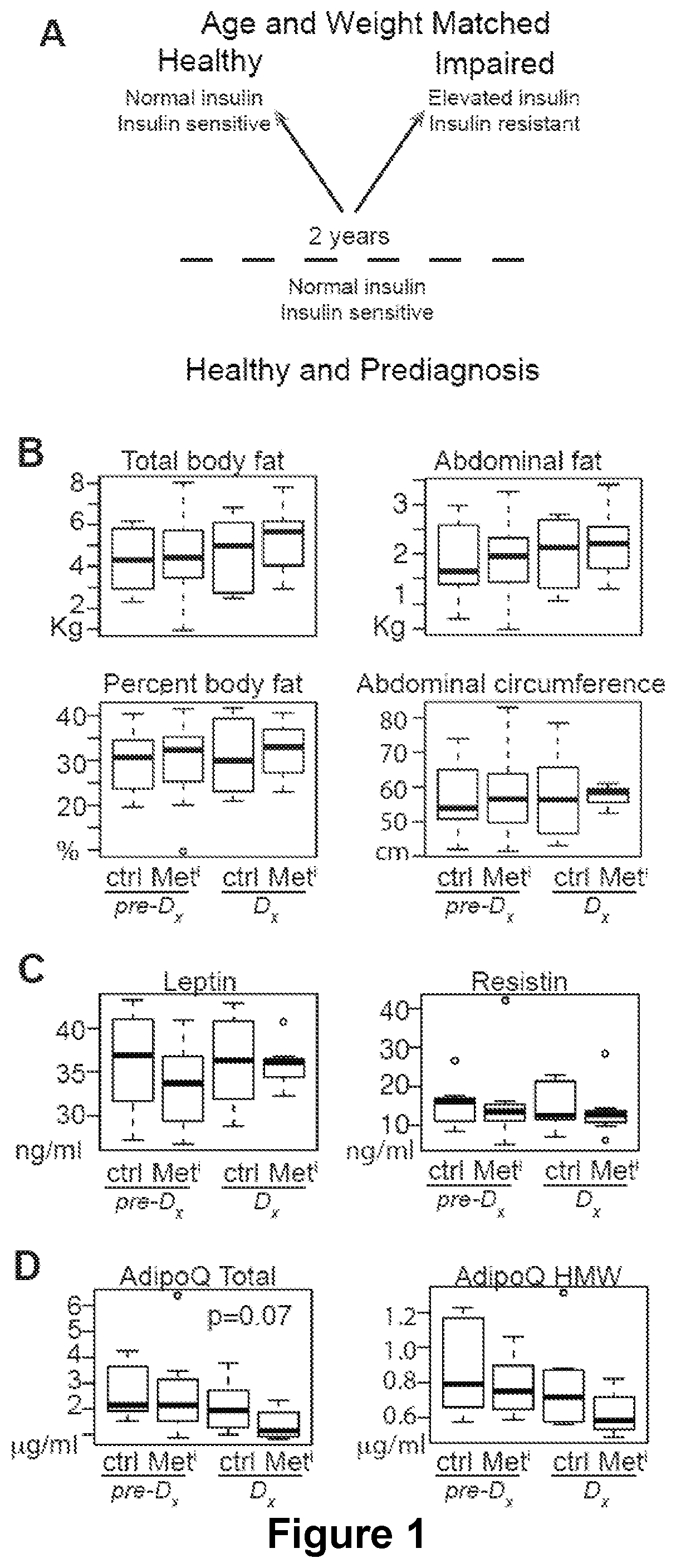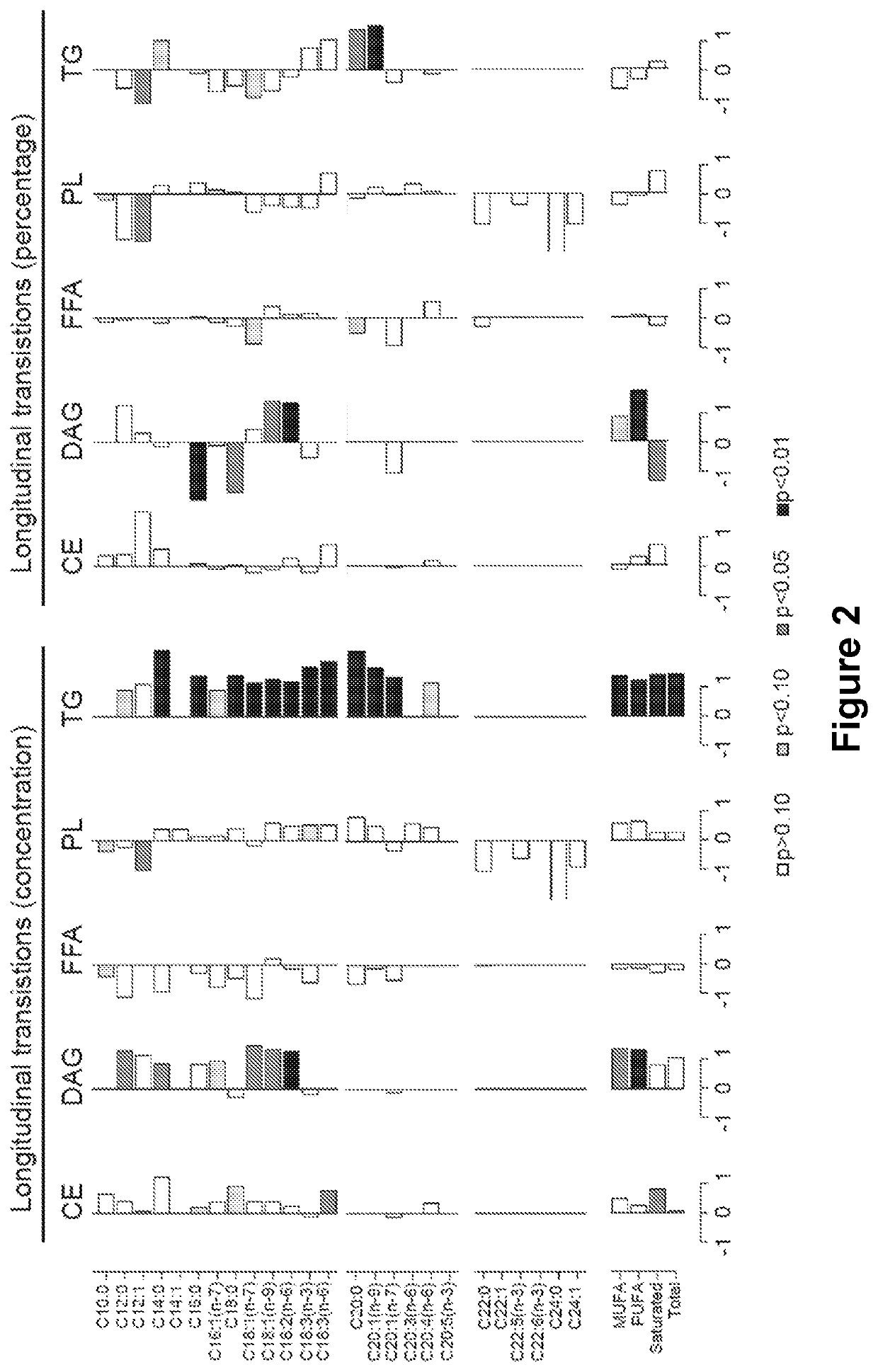Methods for predicting glucoregulatory dysfunction via diacylglycerol fatty acid species concentrations
a technology of diacylglycerol and glucoregulatory dysfunction, which is applied in the field of methods for predicting glucoregulatory dysfunction via diacylglycerol fatty acid species concentrations, can solve the problem of not having biochemical markers that accurately predict which overweight/obese individuals, and achieve the effect of reducing the risk of glucoregulatory dysfunction
- Summary
- Abstract
- Description
- Claims
- Application Information
AI Technical Summary
Benefits of technology
Problems solved by technology
Method used
Image
Examples
example 1
Animal Care and Assessments
[0053]The experiments described herein involved adult male rhesus monkeys of Indian origin from 10 to 22 years of age. Animals were housed individually at the Wisconsin National Primate Research Center and were allowed ad libitum access to food for 6-8 hours per day. All animals were fed a pelleted, semi-purified diet (Teklad, Madison Wis.), which contained 15% lactabumin, 10% corn oil and approximately 65% carbohydrate in the form of sucrose and cornstarch as previously described (Ramsey et al., 2000, Exp Gerontol 35: 1131-1149). Animals had continuous access to water and rooms were maintained at 21-26° C. with ˜50-65% relative humidity. Animals were monitored daily, body weight monitored weekly, and body composition monitored every 6 months by dual energy X-ray absorptiometry (DXA). Glucoregulatory function was monitored every 6 months using established criteria, where levels of fasting plasma glucose and insulin were determined and insulin sensitivity m...
example 2
[0060]Total lipids from experimental animals as described in Example 1 were extracted from ˜200 μl of fasting plasma according to the method of Bligh and Dyer (1959, Can J Biochem Physiol 37: 911-917), and separated by silica gel thin layer chromatography using a mixture of petroleum ether:diethyl ether:acetic acid (at a ratio of 80:30:1) as the developing solvent. Lipids derived from trigylcerides, phospholipids, free fatty acids and diacylglycerol were scraped, methylated, and analyzed by gas-liquid chromatography on a capillary column coated with DB-225 (30-m length, 0.25 mm, internal diameter, 0.25 μm; Agilent Technologies, Inc., Wilmington, Del.). Fatty acids were identified by comparison of retention times with authentic standards (Sigma). Pentadecanoic acid (15:0) was included as an internal standard to control for transmethylation efficiency. Except for absolute concentrations of DAG and FFA (where n=5 control and n=7 impaired), all analyses including r...
example 3
in Profiling: Distinct Plasma Lipoprotein Profiles Predict Metabolic Syndrome
[0066]Lipoprotein particles of different sizes were detected in rhesus monkey blood plasma specimens by NMR spectroscopy using the LipoProfile® test through contract with LipoScience, Inc. Analysis also included chemical detection of total HDL, total LDL, total cholesterol, total triacylglycerol, and CRP, and calculated levels for HDL cholesterol and combined total VLDL and chylomicrons using NMR spectroscopy using the LipoProfile®.
[0067]To understand whether differences in fatty acid composition among the lipid classes were also associated with differences in circulating lipoproteins, NMR-based lipoprotein profiling was conducted using biosamples form healthy and impaired animals. In human studies, low levels of HDL (high density lipoprotein) have been shown to be a hallmark of metabolic syndrome, and an imbalance between circulating levels of HDL relative to LDL and VLDL (low and very low density lipoprot...
PUM
| Property | Measurement | Unit |
|---|---|---|
| time | aaaaa | aaaaa |
| internal diameter | aaaaa | aaaaa |
| length | aaaaa | aaaaa |
Abstract
Description
Claims
Application Information
 Login to View More
Login to View More - R&D
- Intellectual Property
- Life Sciences
- Materials
- Tech Scout
- Unparalleled Data Quality
- Higher Quality Content
- 60% Fewer Hallucinations
Browse by: Latest US Patents, China's latest patents, Technical Efficacy Thesaurus, Application Domain, Technology Topic, Popular Technical Reports.
© 2025 PatSnap. All rights reserved.Legal|Privacy policy|Modern Slavery Act Transparency Statement|Sitemap|About US| Contact US: help@patsnap.com



